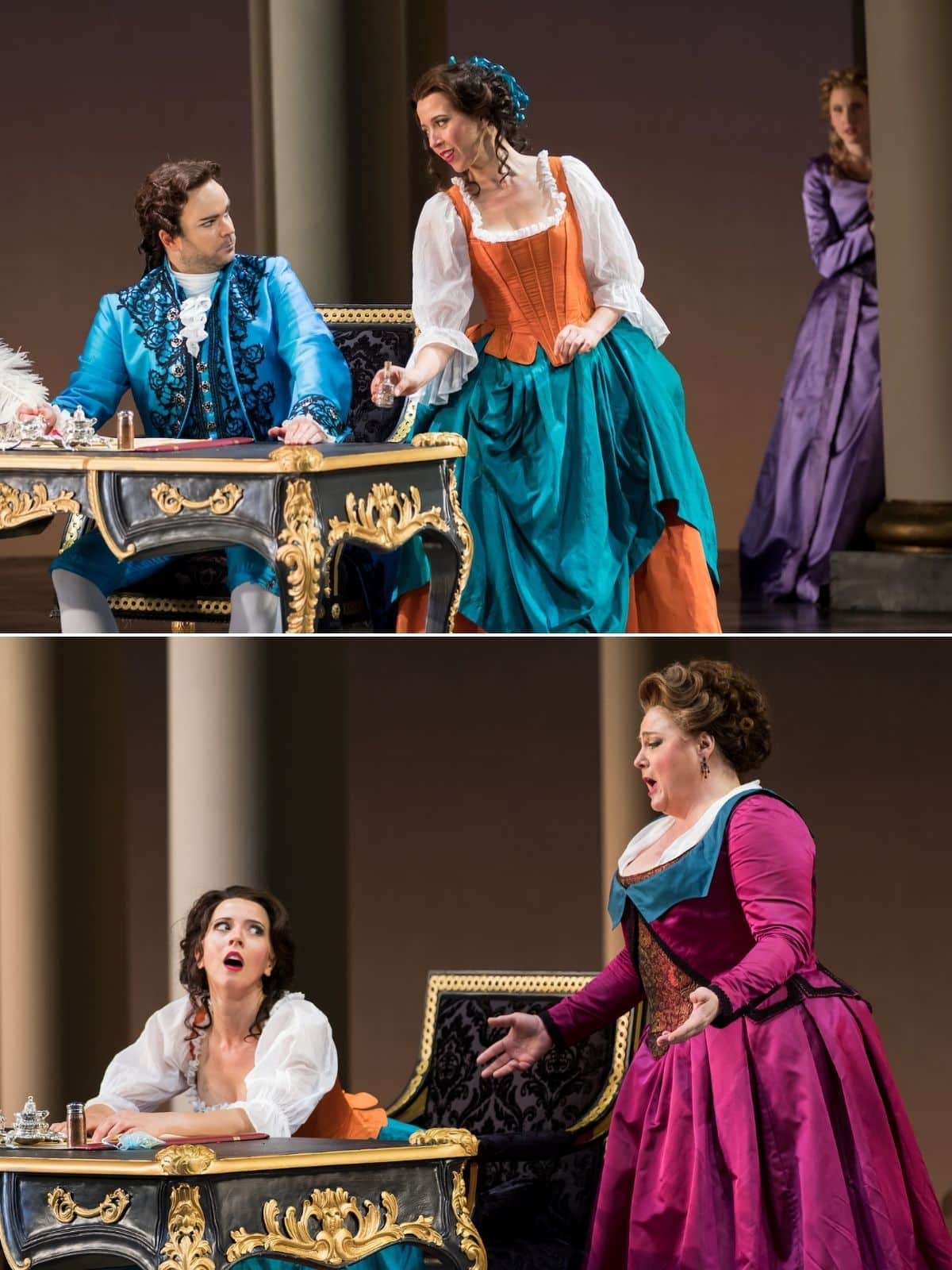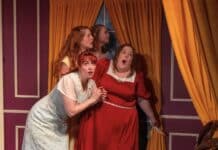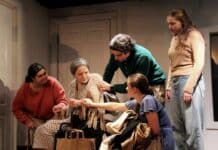Upon entering the prestigious Kennedy Center Opera House, I was immediately welcomed by the glittering raindrops of pure light reflecting off the abstract crystal chandeliers that adorn its mesmerizing domed ceiling. As the lights began to dim, the crowd erupted into applause in eager anticipation of director Peter Kazaras’s production of Wolfgang Amadeus Mozart’s beloved 1785 comedic opera with a libretto by Lorenzo Da Ponte, The Marriage of Figaro.
The Marriage of Figaro is the most frequently performed opera in the world. It’s a comedy for the masses, intended to infuse the traditional comedic elements of opera with an honest insight into character development and emotional poignancy. Although the stunning theater was packed to the rafters, as I looked around, I didn’t see many “young” faces. Opera hasn’t always been a millennial magnet; however, The Marriage of Figaro is the perfect starter show for anyone interested in breaking that dated stereotype.
The orchestra took its place under the incredible direction of the new music director and conductor of the Washington National Opera (WNO), four-time Grammy Award winner Robert Spano. Spano’s keen understanding of Mozart’s delicate yet precise score was palpable from beginning to end. His soft yet structured movements set the tone for the entire evening.

The upbeat melody of the classic overture began before the curtain rose, transporting us first into a uniquely beautiful world where the gold embroidery on the curtain seemed to dance gracefully across the regal red backdrop, curling and swirling with the building strings, winds, and percussion.
The curtain rises on the morning of Figaro (Le Bu) and Susanna’s (Joélle Harvey) wedding day. Bu’s performance as the title character of Figaro was exceptional in every way. His deep bass-baritone voice radiated through to the back of the vast theater with impressive control and emotional resonance. As he crescendoed into fortissimo, I could feel the masterful vibrato deep within my solar plexus.
Despite standing in for the role of Susanna for this particular performance, Harvey’s lovely soprano voice paired beautifully with Bu’s rich timbre. Yaritza Véliz will presumably play the role of Susanna for the remainder of the show’s run. And, while I can’t speak to how that performance may have compared, I can say that Harvey’s rendition of the role — expanding upon her previous experience performing it at the Royal Opera House Covent Garden — was captivating and endlessly endearing. She blended beautifully into the set cast; the genuine and playful love felt between Figaro and Susanna was never in question. Part of this success is also likely due to Intimacy Coordinator Lorraine Ressegger-Slone.
As the happy couple prepare for their pending nuptials, Susanna informs her intended of an obstacle standing in their way, an obstacle by the name of Count Almaviva (Will Liverman). Figaro has served the count as his faithful valet for years, yet all the while, the count has pined for Susanna, the longtime maid and friend to his lonely and disheartened wife, Countess Rosina Almaviva (Rosa Feola).
Feola was the absolute star of the night. Her impeccable performance as the countess left me utterly speechless on multiple occasions with full-body chills. Her voice manifested as an ethereal cloud that floated her out of her body, while at the same time forging deep forest roots that grounded her rich, reverberating tone. She also exhibited stunning breath control as her vocals never wavered despite often projecting from odd or unideal positions, such as lying curled up on her side while emanating intense sorrow or bending to her toes from a seated position to put on stockings.

The Count’s attempts at seduction are continually thwarted, and hilarity ensues. Constant unfortunate coincidences unfold, leading all the characters on an emotional rollercoaster. The series of comedic misunderstandings and mishaps culminates in a scene in the estate’s massive garden wherein Susanna and Rosinna come together with a plan to disguise themselves as one another to teach their jealous husbands a lesson.
Count Almaviva is not the only unsuccessful womanizer. The young page boy Cherubino (John Holiday) falls madly in love (or rather, in lust) with just about every woman he meets. Historically, the character of Cherubino was played by a woman to depict the falsetto tones of a pubescent male. Holiday’s countertenor voice, however, paired with his spot-on comedic timing, brought the endearing character to life in a new and exciting yet intimately familiar way.
Meanwhile, other players within the Count’s household take sides and make moves, such as Marcellina (Elizabeth Bishop), to whom Figaro owes a debt — a debt that Marcellina intends to use as blackmail to get him to marry her (despite the fact that she’s old enough to be his mother). The others in the house act mostly out of self-interest, except for Don Basilio (Rodell Rosel), who seems to just love drama and revels gleefully in the messy chaos.
The production was elevated even further by the costumes, sets, and lighting. Costume Designer Myung Hee Cho mirrored the energetic tone of the show through bright colors, including sunset orange, Mediterranean Sea blue, cascading shades of lilac, and vivid pinks and fuchsias. The costumes also furthered the buoyant, meaningful (often metaphorical) movements created by Choreographer Karma Camp.
Set Designer Benoit Dugardyn’s black-and-white checkered floor, colossal columns, and regal gold-accented pieces created a captivatingly elegant and impressive stage that grew in its impressive nature through each act as elements were removed to reveal the grandeur of scale hiding behind. Dugardyn’s design was beautifully outlined by the calculated lighting of Production Lighting Designer A.J. Guban and Original Lighting Designer Mark McCullough. The stunning backdrops, transitioning from a smooth, subtle sunset to a starry night sky, allowed the audience to travel seamlessly through the characters’ journeys.
While the plot may not be entirely contemporary, the themes are timeless. Motifs of love, integrity, jealousy, and forgiveness drive the story and the characters. These have a place in classic and contemporary works alike, which makes The Marriage of Figaro the perfect introduction to those new to the magical world of opera.
Not to mention, we could all use a few more laughs in these dark days, and this opera is a comedy that will have you laughing out loud from the moment these incredible performers grace the stage. And, again, for those new to opera, while the songs are sung in the traditional Italian, the words are translated and projected in English for the audience to follow along.
Opera is a truly magical art form that should be experienced by all. Let’s start with getting everyone to the Kennedy Center to witness this incredible performance of the classic comedy, The Marriage of Figaro, playing now through November 22.
Running Time: Three hours and 15 minutes, including a 25-minute intermission.
The Marriage of Figaro plays through November 22, 2025, presented by the Washington National Opera performing in The Opera House at the John F. Kennedy Center, 2700 F St. NW, Washington, DC. For the schedule and to purchase tickets (starting at $57), go online or contact the Box Office at (202) 467-4600.
In Italian with projected English titles.
The program for The Marriage of Figaro is online here.
The Marriage of Figaro
Music by Wolfgang Amadeus Mozart
Libretto by Lorenzo Da Ponte
Directed by Peter Kazaras
Conducted by Robert Spano



